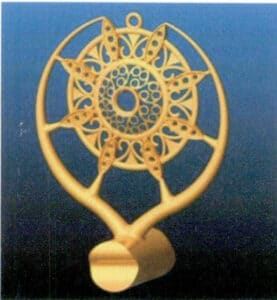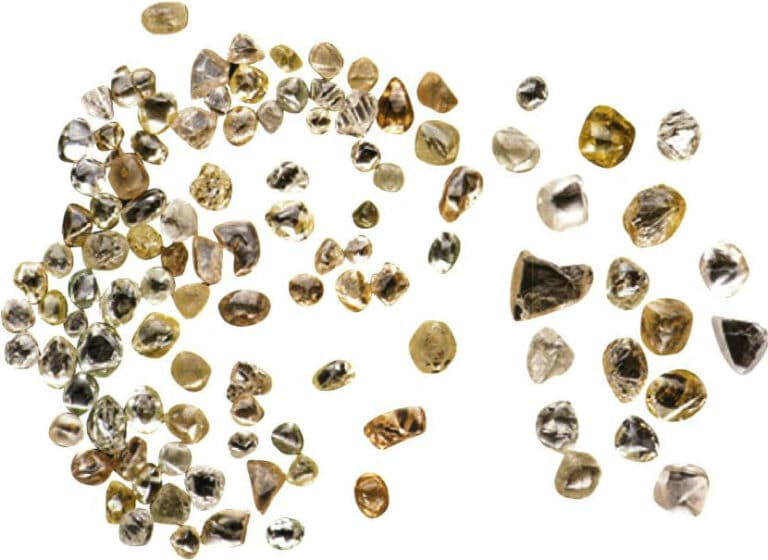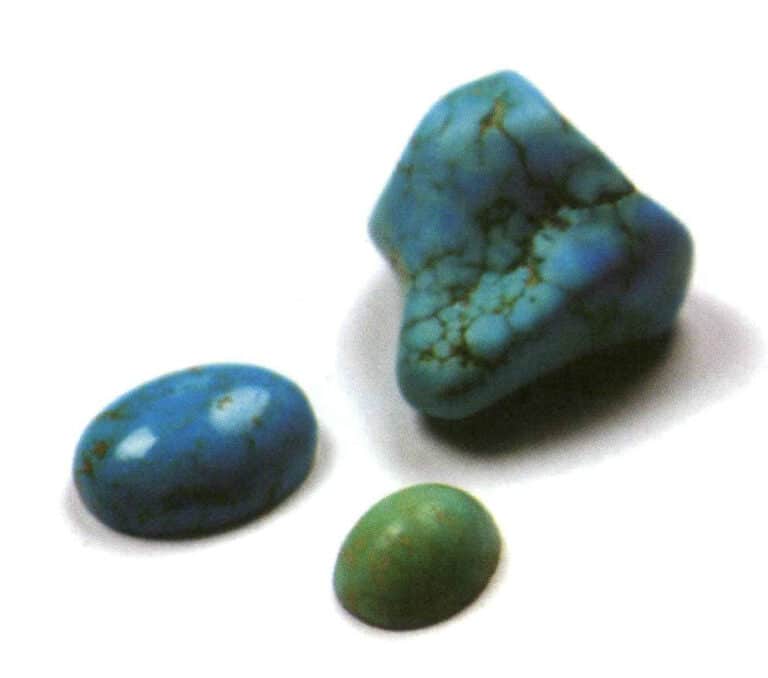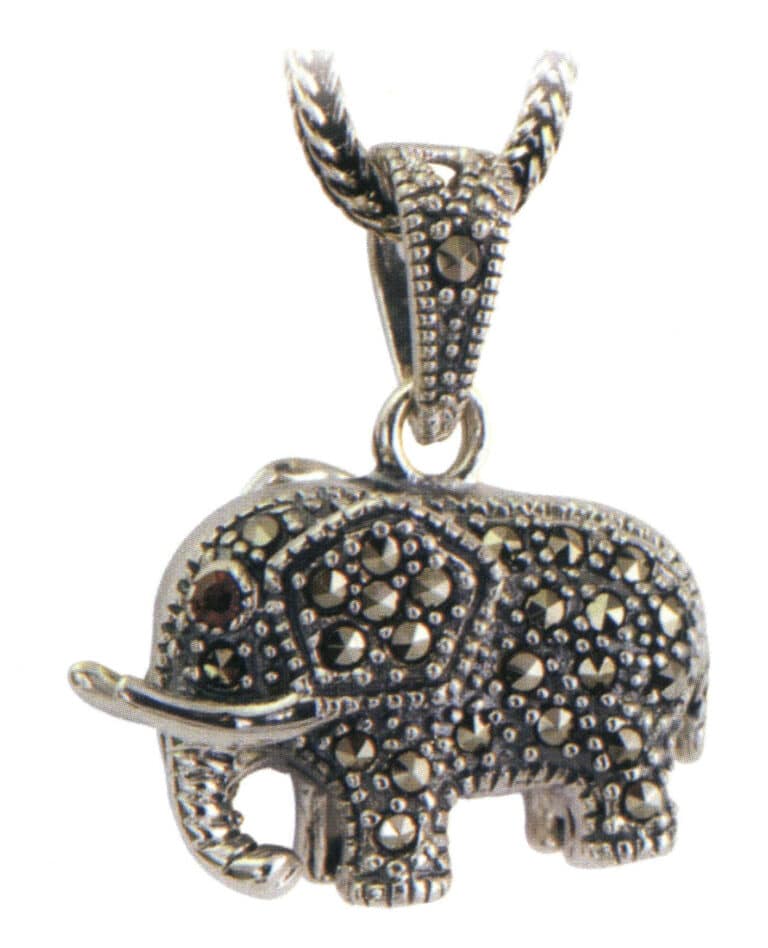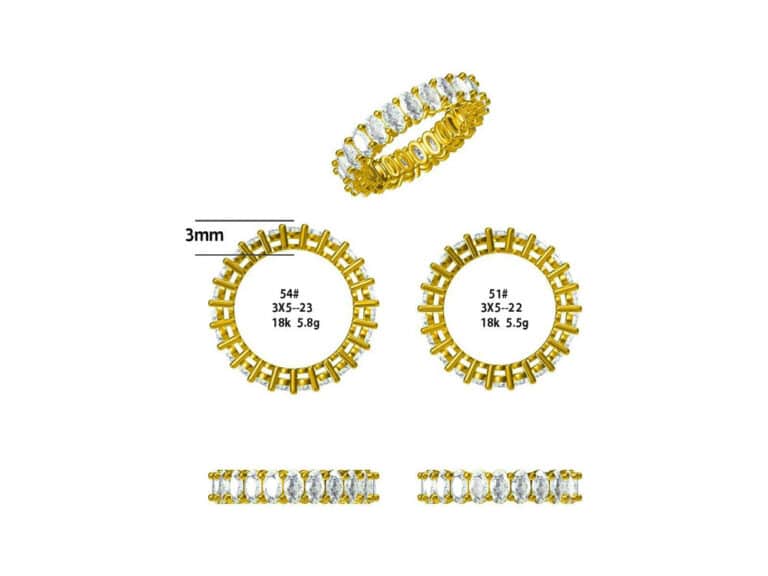Sobling mücevher kalıplarının kalitesini nasıl kontrol ediyor?
Kuyumculuk Ana Kalıp Kalite Denetimi ve Kusur Analizi
Giriş:
Mücevher ana kalıbı, mücevher işleme sürecindeki ilk işlemdir. Aşağıdaki yöntemler genellikle bunu yapar: ilk olarak, keskin kenarlı, net çizgili ve pürüzsüz yüzeyli bir ana kalıp oluşturmak için el yapımı ana kalıp, yani testere, dosyalama, kaynak, gravür vb. İkincisi, bir balmumu modelini elle oymak ve ardından bunu bir ana kalıba dökmek. Üçüncü olarak, balmumu veya reçine modelleri yapmak için çeşitli hızlı prototipleme yöntemleri kullanılır ve daha sonra bunlar gümüş versiyonlara dökülür veya doğrudan metalden ana kalıplar haline getirilir. Modern mücevher üretiminde, hızlı prototipleme teknolojisi kalıp yapımının verimliliğini artırmak için giderek daha fazla kullanılmaktadır.
Kuyumculuk ana kalıbının kalitesi, kuyumculuk ürünlerinin üretim verimliliği, üretim maliyeti ve ürün kalitesi üzerinde önemli bir etkiye sahiptir. Makul bir yapıya ve temiz bir yüzeye sahip kaliteli bir mücevher ana kalıbı, ikinci sürecin işleme iş yükünü azaltabilir. Aksine, kalitesiz bir kuyumculuk ana kalıbı yalnızca düşük kaliteli ürünler üretebilir, çünkü kuyumculuk ana kalıbındaki kusurlar ürüne sadık bir şekilde kopyalanacak ve bu da bir grup ürünün hurdaya çıkmasına veya artan onarım iş yüküne neden olacaktır. Bu nedenle, mücevher ana kalıbı, mücevher ürünlerinin müşterinin temel kalite gereksinimlerini karşılamasını sağlamak içindir ve ana kalıp kalite kontrolünü ve testini güçlendirmelidir.
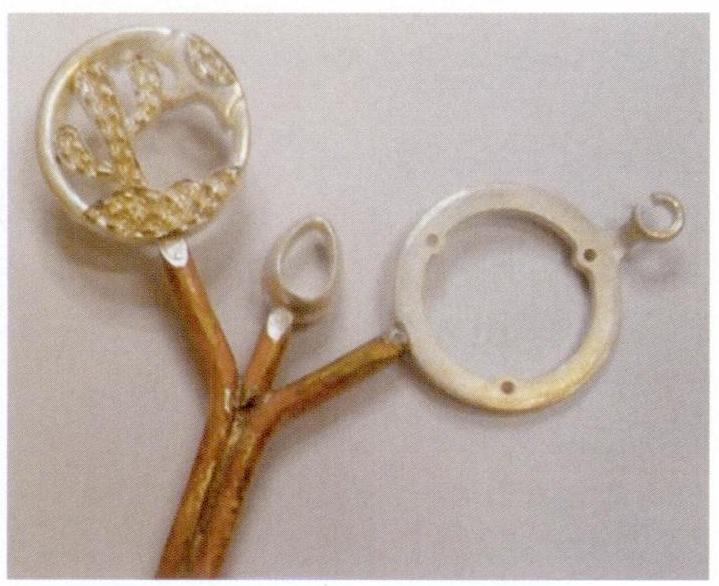
İçindekiler
Bölüm I: Ana kalıp kalite kontrol içeriği
Ana kalıp kalite denetiminin ana içeriği şekil, boyut, ağırlık, yapı, yüzey kalitesi, döküm yolluk vb. içerir.
1. Şekil
Bir mücevher ana kalıbı için en temel gereklilik orijinal görünümü geri kazanmaktır; yani ana kalıbın üretimi, tasarım çizimlerinin gerekliliklerine veya tasarımcının niyetlerine kesinlikle uygun olmalıdır. Bunu başarmak için, operatör öncelikle tasarımcının fikirlerini ve temalarını derinlemesine deneyimlemek ve anlamak için üç boyutlu düşünmeyi kullanmalı ve ayrıca ana kalıbın bütünlüğünü, koordinasyonunu ve estetiğini göz önünde bulundurmalıdır.
2. Boyut Kontrolü
Farklı mücevher türlerinin hem standart boyut gereksinimleri hem de numune yapımı sırasında dikkate alınması gereken her tür için özel boyutları vardır. Örnek olarak yüzükleri ele alırsak, Şekil 5-1'de gösterildiği gibi her bir parçanın özel boyut gereksinimleri vardır.
2.1. Yüzükler
Parmak Ölçüsü: Yüzüğün iç çapını ifade eder, genellikle parmak numarası ile gösterilir.

Sap Genişliği: Yüzüğün alt kısmındaki sapın genişliğini ifade eder.
Şaft Kalınlığı: Halkanın alt kısmındaki sapın kalınlığını ifade eder 0,6-0,7 mm
Ayar Bağlantısı Kalınlığı: Baş kenarında değerli taş bulunmayan parçanın kalınlığı. Bir kumpas ile ölçün; müşteri gereklilikleri sağlamazsa, 0,6-0,7 mm
Çatal Kalınlığı: Değerli taşlar için çatal ayarının kalınlığı bir kumpas ile ölçülür. Müşteri gereklilikleri sağlamazsa, 1-1,2 mm kullanılabilir.:1,5-1,8 mm
Taş bağlantıları kenar kalınlığı: Kenar kalınlığı gibi taş ayarının etrafındaki kenarın kalınlığı 1,5-1,8 mm olabilir.
2.2. Kolye
Toplam uzunluk: toka bağlantı kısmı hariç toplam uzunluk. Genel olarak kolyeler 16 ila 17 inç, bilezikler ise yaygın olarak 6,5 ila 7 inçtir.
Bağlantı uzunluğu: tek bir bağlantının uzunluğu.
Gövde kalınlığı, ayar kalınlığı ve taş ayar kenarının kalınlığı için gereklilikler yüzüklere benzerdir.
2.3. Bilezik
İç Çap: Bileziğin iç çapını ifade eder, genellikle boyut numarasıyla ifade edilir.
Genişlik: Bilezik duvarının enine kesit genişliğini ifade eder.
Gövde kalınlığı, ayar kalınlığı ve taş ayar kalınlığı için gereklilikler yüzüklere benzer.
Ana kalıp boyutunu kontrol etmek için kullanılan araçlar arasında sürmeli kumpaslar, halka mastarlar, iç kumpaslar vb. bulunur. Ana kalıp boyutu çizimlere göre belirlenmeli, ancak büzülme ve müteakip işleme payları ayrılmalıdır. Yani, ana kalıp boyutu=ürün boyutu x (1+ büzülme oranı )+ işleme payı gerektirir.
Farklı yönlerdeki büzülme oranlarının farklı olduğunu ve farklı ürün yapıları ve malzemelerin de büzülme oranını etkileyeceğini unutmayın. İşleme payı, dökümün yüzey kalitesine; kullanılan yüzey işleme yöntemine ve gerekli yüzey kalitesi derecesine göre belirlenmelidir. Genel olarak, 0,1-0,6 mm eşit olmayan alın. Döküm kalitesi düşük olduğunda, manuel işleme kullanıldığında ve yüzey kalitesi gereksinimleri yüksek olduğunda, ayrılan işleme payı daha önemli olmalıdır.
Kalıplanmış iş parçası iyi yüzey yoğunluğuna ve pürüzsüzlüğe sahiptir, bu nedenle ayrılmış işleme payı daha küçük olabilir. Bu nedenle, ana kalıp boyutunun belirlenmesi sabit değildir ve gerçek duruma göre belirlenmelidir.
3. Ağırlık
Ana kalıp ağırlığı büyük ölçüde ürünün ağırlığını belirler. Ana kalıp malzemesi ve ürün malzemesi seçildiğinde, ağırlıkları arasında yaklaşık orantılı bir ilişki vardır. Bu nedenle, ana kalıbın ağırlığı kontrol edilerek ürünün ağırlığı kontrol edilebilir.
El yapımı gümüş kalıplar için gümüşün ağırlığı, gümüş ve ürün malzemesi arasındaki orantı ilişkisi ile doğrudan belirlenebilir. El oyması balmumu kalıplar için genellikle önce balmumu kalıpların ağırlığı kontrol edilir. Balmumu kalıplar ana kalıplara döküldükten sonra, ana kalıpların ağırlığı ana kalıpların taşınması ve detayların rafine edilmesi ile kontrol edilir. Balmumu ve metal arasındaki yaklaşık oran ilişkisi aşağıdaki gibidir:
| Metal Tipi | 1 gram Balmumu modeli = Döküm sonrası metal ağırlığı |
|---|---|
| Som Gümüş | 10 gram |
| 24 Ayar Altın | 20 gram |
| 18 Ayar Altın | 15 gram |
| 14 Ayar Altın | 14 gram |
| 10 Ayar Altın | 10 gram |
4. Ana kalıp yapısı
Makul bir şekilde yapılandırılmış bir ana kalıp, seri üretim sırasında iş yükünü önemli ölçüde azaltabilir ve kalite sorunları olasılığını azaltabilir; tersine, ana kalıp yapısı mantıksız olduğunda, seri üretim sırasında genellikle iki kat sonuç için yarı çaba gösterme durumu vardır. Bu nedenle, ana kalıp yapılmadan önce sonraki üretim operasyonları dikkatli bir şekilde değerlendirilmeli ve ilgili ana kalıp yapısı tasarlanmalıdır. Ana kalıbın yapısı ana gövdeyi, bileşenleri, ekleri, aksesuarları, işlem eklerini vb. içerir.
4.1 Ana gövde:
Ana kalıbın orta kısmını ifade eder.
Bileşenler: Önemli üretim zorlukları, kalite güvence zorlukları ve yüksek üretim maliyetleri olanlar gibi daha karmaşık ana kalıplar, genellikle ayrı üretim için birkaç bileşene ayrılır ve bu bileşenler daha sonra birleştirilir.
4.2 Uçlar:
Ana kalıp gövdesine gömülü küçük aksesuarları ifade eder. Ek parçaları monte ederken ve sabitlerken, genellikle kaynak gereklidir ve kaynak mukavemetine ve kullanılan kaynak malzemelerinin miktarına dikkat edilmelidir.
4.3 Ayar:
Değerli taşları ayarlamak için kullanılan tabanı ifade eder. Sipariş gereksinimlerine göre belirlenmesi gereken çeşitli ayar türleri vardır. Ayarın konumu, boyutu, taş ayar tabanı derinliği ve tırnakların boyutu ve uzunluğu ayar kalitesi üzerinde önemli bir etkiye sahip olacaktır.
4.4 Menteşe:
İki bileşeni birbirine bağlamak ve dönmelerini sağlamak için kullanılan mekanik bir cihazı ifade eder. Menteşeler genellikle küpe, bilezik ve broş gibi takılarda kullanılır. Mandrenlerin esnekliği ve dayanıklılığı, takı kullanımının işlevselliğini doğrudan etkiler.
4.5 Kulak iğnesi:
Bir küpede kulak deliğinden geçen ve genellikle bir kulak klipsi ile kullanılan metal çubuğu ifade eder. Kulak piminin konumu, uzunluğu, kalınlığı vb. ana kalıp yapısına göre belirlenmelidir.
4.6 Dil ile kutu toka:
Bileziklerin, bilek zincirlerinin vb. açık bağlantı kısımlarında kullanılan, dil(yaylı parça) dahil olmak üzere sabitleme bağlantılarını ifade eder ve onunla birlikte kullanılan toka kutusu.
4.7 El işi aksesuarları:
Bitmiş mücevher üzerinde bulunmayan ancak üretim süreci gereklilikleri nedeniyle eklenen ekstra yolluklar, yamalar vb. gibi bazı aksesuarları ifade eder. Bu aksesuarların genellikle belirli üretim süreçleri tamamlandıktan sonra çıkarılması gerekir.
5. Ana kalıp yüzey kalitesi
Ana kalıp yüzey kalitesinin ürün kalitesi, üretim verimliliği, üretim maliyeti vb. üzerinde önemli bir etkisi vardır. Ana kalıp üzerinde fazladan çalışma yapmak, üretimde ölçülmesi zor getiriler sağlayabilir, ancak bazı üreticiler genellikle bu basit gerçeği fark edemezler. Ana kalıp yüzeyi pürüzsüz ve hassas olmalı, gözle görülür kum gözleri, delikler, çizikler veya düzensiz kenarlar içermemelidir.
6. Döküm yolluk
Döküm yollukları, döküm işleminde erimiş metalin akışı için bir kanal olarak ayrılmıştır. Mücevher dökümünde, döküm kalitesinin sağlanması için döküm yolluklarının doğru ayarlanması önemli bir koşuldur. Yetersiz dolum, büzülme ve gözeneklilik gibi makul olmayan döküm yolluk ayarları, doğrudan veya dolaylı olarak hassas dökümde birçok yaygın hataya neden olur. Döküm yolluk ayarının rasyonelliği esas olarak döküm yolluklarının konumu, miktarı, şekli, boyutu ve bağlantı yöntemi gibi yönlerden değerlendirilir.
(1). Ana kalıp yapılırken, döküm yollukları ana kalıbın ayrılmaz bir parçası olarak kabul edilmeli ve ana kalıba yüksek lehimle kaynaklanmalıdır. Bu tür döküm yollukları balmumu veya erimiş metalin doldurulması için faydalıdır. Ana kalıpta döküm yolluk yoksa ve bir neşterle kauçuk kalıp üzerinde rastgele kazılırsa, böyle bir kanal doluma elverişli olmayan türbülansa eğilimlidir.
(2). Döküm yolluk, dökümün en kalın kısmına bağlanmalı ve kesitinin eşdeğer kalınlığı dökümünkinden daha büyük olmalıdır. Döküm yolluk büzülmeyi telafi etme işlevine sahip olduğundan, dökümde büzülme ve büzülme delikleri gibi kusurları önlemek için katılaşma süresi dökümünkinden daha geç olmalıdır. Döküm yolluk ve iş parçası arasındaki bağlantı yöntemi de dökümün kalitesi üzerinde önemli bir etkiye sahiptir. Dik açılı bir bağlantı veya bağlantı noktasında boyun oluşturma, erimiş metalin dolmasına elverişli değildir ve türbülansa neden olabilir. Döküm yolluklarının kökünde, dökümle birleştiği yerde yuvarlatılmış bir köşe dökülmeli ve köşenin yarıçapı kontrol edilmelidir. Etkili olamayacak kadar küçük köşelerden ve temizleme zorluğunu artıracak kadar büyük köşelerden kaçınmak gerekir.

(3). Yolluk uzunluğu makul olmalıdır. Yolluk kanalından akan mum veya metal sıvı işlemi kademeli bir soğutma işlemidir. Yolluk daha kısa olursa, doluma elverişli olur ve dolum hatalarına yol açabilir. Ancak yolluk uzunluğunun çok kısa olması, iş parçasının çekirdeğe çok yakın olmasına neden olur. Bu durumda, sadece tek bir döküm metalinin iş parçalarının sayısını azaltmakla kalmaz, aynı zamanda iş parçasının aşırı ısınması nedeniyle büzülme kusurları olasılığını da artırır.
(4). Yolluk sayısı iş parçasının yapısına göre belirlenmelidir. Doldurma ve besleme gereksinimlerini karşılama öncülünde, yolluk sayısını azaltmak taşlama ve temizleme iş yükünü azaltabilir ve işlemin verimini artırabilir; ancak, iş parçası nispeten ince ve karmaşık veya büyükse, gereksinimleri karşılamak için tek bir yolluktan daha fazlasına ihtiyaç duyulduğunda, iki veya daha fazla yolluk kullanılmalıdır.
(5). Döküm yolluklarının şekli. Üretimde yaygın olarak görülen döküm yolluklarının kesit şekilleri arasında dairesel, kare, üçgen vb. bulunur. Sadece erimiş metalin düzgün akışını kolaylaştırmakla kalmayıp aynı zamanda ısı kaybını azaltarak kanalı korumak ve büzülme kanalını tutmak için gereken süreyi uzattığından, öncelikle dairesel bir kesit kullanılması önerilir. Döküm yollukları tek dallı, Y şekilli, V şekilli, kanca şekilli, dairesel vb. gibi çeşitli şekillerde gelir ve seçim iş parçasının gerçek durumuna göre yapılmalıdır.
Bölüm II. Kalite Denetim Personeli ve Yöntemleri
Kuyumculuğun diğer süreçlerindeki kalite denetçileri ile karşılaştırıldığında, ana kalıp kalite denetçilerinin gereksinimleri ve zorlukları çok daha yüksektir. Sektörde yaygın olarak kalıp izleyicileri veya kalıp müfettişleri olarak anılırlar. Mükemmel bir kalıp izleyicisinin, mesleği tasarımcı olmasa bile mücevher tasarımını anlaması, ancak tasarımcının çalışmalarını net bir şekilde anlaması ve 3D tasarım çizimlerini anlayabilmesi gerekir. Ana kalıp yapımında zengin deneyime sahip olmalı ve gümüş ana kalıp yapısı, gümüş ana kalıp üretim süreçleri ve kalite gereksinimleri konusunda yetkin olmalıdırlar. Ana kalıp yapım departmanının operasyon sürecine aşina, mücevher yapımının üretim ve işleme bağlantılarına aşina, fabrikalarda uzun süreli pratik deneyime sahip, süreçler ve üretim akışı hakkında kapsamlı bir anlayışa sahip, mücevher malzemeleri hakkında özel bir bilgiye sahip ve anormal üretim sorunlarını tahmin etme yeteneğine sahip.
Günümüz kuyumculuk üretim yöntemlerinde, ana kalıbın kalitesini etkileyen birkaç temel faktör vardır.
Bunlardan biri CAD çizimlerinin gözden geçirilmesidir; CAD çizimleri yapılırken ana kalıp şekli, boyutu, yapısı ve kuyumculuk üretim süreciyle ilgili hususlar dikkatle değerlendirilmelidir. Bununla birlikte, birçok CAD taslağı hazırlayıcısı üretim süreçlerine aşina değildir, bu nedenle tasarımcıların sadece estetiği ve şekilleri kavramak için CAD çizimlerini gözden geçirmeleri gerekmez, aynı zamanda gözden geçirenlerin yapısal ve süreç incelemeleri yapmaları ve değişiklik önerileri ve gereksinimleri sağlamaları gerekir.
İkinci olarak, hızlı prototipleme balmumu veya reçine modellerinin sağlam olup olmadıklarını veya eksik parçalar, deformasyonlar, kum delikleri vb. gibi kusurları olup olmadığını kontrol etmek için incelenmesi gerekir. Bu tür kusurlar bulunduğunda, gümüş döküm için düzenleme yapılmadan önce onarımlar yapılmalıdır. Onarım mümkün değilse, yeni balmumu veya reçine modeller yapılmalıdır. El oyması balmumu modeller de dikkatle incelenmelidir.
Üçüncü olarak, çoğaltılmış gümüş modeller üzerinde incelemeler yapılmalı, gümüş modellerin sağlam olup olmadığı veya ciddi kusurları olup olmadığı kontrol edilmeli ve şekiller, yapılar, montajlar, boyutlar, süreçler, yüzey kalitesi vb. üzerinde incelemeler yapılmalıdır.
Ana kalıbı inceleme araçları nispeten basittir. Dış şekil, yapı, çekicilik vb. esas olarak görsel gözleme dayanır. Boyut denetimi bir halka ölçer, kumpas, iç kumpas vb. kullanılarak yapılabilir. Yüzey kalitesi çıplak gözle ve büyüteçle kontrol edilebilir.
Bölüm III. Ana kalıbın yaygın kusurları
7. Şekil tutarsızlığı
Mücevher ana kalıpları genellikle tasarım çizimlerine, eskizlere veya şekil için müşteri sözlü gereksinimlerine sahiptir. Ana kalıp tamamlandıktan sonra çizimlere göre kontrol edilmeli veya müşteri tarafından onaylanmalıdır.
【Vaka 5-1】Halkanın iç kenarı Şekil 5-2'de gösterildiği gibi bir iç yay gerektirir.
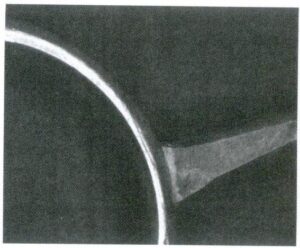
Analiz:
Takılar kullanım rahatlığını göz önünde bulundurmalıdır. Yüzüğün iç kenarı genellikle yuvarlatılmış bir köşe gerektirir, ancak genellikle üretim sırasında düz bir kenar haline getirilir.
【Vaka 5-2】 Şekil 5-3'te gösterildiği gibi deformasyon.

Analiz:
Ana kalıpla ilgili deformasyon sorunları, genellikle hassas olan ve dış kuvvetlere dayanma kabiliyeti zayıf olan mücevher yapısı da dahil olmak üzere üretimde sıklıkla ortaya çıkar. Genellikle 925 gümüşten yapılan ana kalıbın malzemesi de bir faktördür. K altın, bakır alaşımları vb. gibi kuyumculukta yaygın olarak kullanılan diğer malzemelerle karşılaştırıldığında, gümüş alaşımları daha düşük mukavemet ve sertliğe sahiptir, bu da üretim sürecinde, özellikle sıkıştırmalı kalıplama işlemi sırasında ana kalıbın deformasyonuna yol açar.
Çözümler:
Ana kalıp deformasyonu sorununa yönelik birkaç çözüm bulunmaktadır. İlk olarak, çok hassas veya çok geniş bir düz yüzeye sahip olmaktan kaçınmak için ana kalıp yapısında gerekli ayarlamaları yapın; ikinci olarak, Şekil 5-4'te gösterildiği gibi, çeşitli izole çalıştırma kollarını çekme çubuklarıyla bağlamak için işlem çekme çubukları kurun, böylece çalıştırma çubuğu deformasyonu olasılığını önemli ölçüde azaltın; üçüncü olarak, gümüş versiyonu yapmak için daha iyi performansa sahip malzemeler seçin. Son yıllarda, sektördeki bazı üreticiler yüksek sertlikte gümüş alaşımları geliştirmek için faydalı girişimlerde bulunmuş, eser alaşım elementleri ekleyerek ve üretim sürecini rafine ederek alaşımın mukavemetini ve sertliğini önemli ölçüde artırmıştır.
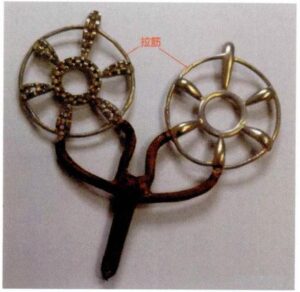
[Vaka 5-3] Ana kalıp Şekil 5-5'te gösterildiği gibi çekicilikten yoksundur.

Analiz:
Bir ürün sadece fiziksel bir forma değil, aynı zamanda bir cazibeye de sahip olmalıdır; aksi takdirde, özellikle bazı figür ve hayvan stilleri için daha canlı bir canlılığa ihtiyaç duyacaktır. Ancak, ana kalıp üretiminde cazibeyi kavramak kolay değildir. Önemli sanatsal beceriler gerektirir. Çoğu zaman sadece anlaşılabilir ve kelimelerle açıklanamaz.
Çözümler:
Ana kalıp hayvan tasarımlarında, hızlı prototipleme için bilgisayar çizimi kullanmak genellikle mekanik ve katı görünür. Elle balmumu oymaya öncelik verilmesi veya birincil gövde modelini oluşturmak için bilgisayar çizimi kullanılması ve ardından elle işlenmesi tavsiye edilir.
[Durum 5-4 ] Şekil 5-6'da gösterildiği gibi ana kalıp üzerindeki kakma kenarı yuvarlatılmamıştır.

Analiz:
Zımparalama sırasındaki yanlış teknik, ana kalıp üzerindeki kakma kenarını bir çokgene dönüştürmüş ve yuvarlatma gerekliliğini karşılamamıştır.
[Durum 5-5 ] Şekil 5-7'de gösterildiği gibi ana kalıp üzerindeki deliğin kenarı kırık ve eksiktir.

Analiz:
Bu örnekte, dökümden sonra her üç dairesel delikte de gözle görülür çökme kenarları oluşmuş ve bu da dairesel deliklerde ciddi deformasyona yol açmıştır. Çökme kenarının nedeni, belirli nedenlerden dolayı kalıbın kalitesi ve döküm sırasındaki döküm işlemiyle yakından ilgilidir.
8. Boyutsal Tutarsızlık
Jewelry does not have the exact strict requirements for dimensions as mechanical parts, but when it comes to wearing, setting, and assembly, such as ring size, bracelet opening size, bracelet length, coordination between necklace and pendant bail rings, and coordination between inlay and base, accurate dimensions of the master mold are required.
【Case 5-6】The size of the pendant bail does not match.
Analiz:
The pendant bail of the pendant has various specifications. Its size is generally determined based on the shape size, structure, and material of the pendant and the size of the matching chain. The size of the hole through which the pendant bail is threaded should ensure that the chain passes smoothly. Otherwise, there may be wearing issues.
【Case 5-7】The length of the bracelet does not meet the requirements of the drawing.
Analiz:
The length of the bracelet is an essential indicator of its wearing comfort. The size of each link must be determined based on the number of links and the total length of the bracelet required by the drawing, combined with shrinkage and processing allowances. The drawings of jewelry products are often less standardized than those in the mechanical processing industry. It is expected that the drawing will be marked or changed arbitrarily. The size and structural requirements of the bracelet in Figure 5-8 are typical examples. Therefore, when making the master mold, it is necessary to read the requirements of the drawing carefully. If there are any doubts, promptly inquire with the customer to confirm, and not handle it based solely on one’s own understanding.
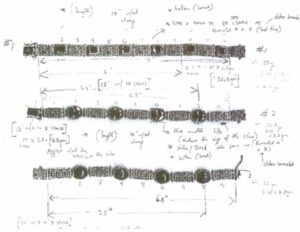
[Case 5-8] The setting size does not match the gemstone, as shown in Figure 5-9.
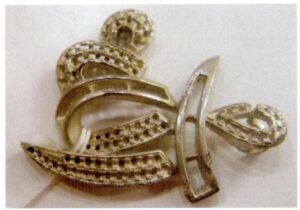
Analiz:
The ladder-shaped diamonds are a commonly used setting method in diamond jewelry. Generally, multiple diamonds need to be arranged in a setting, requiring the diamonds to be arranged closely, smoothly, and seamlessly, with no apparent gaps between diamonds or between diamonds and the ends of the setting. However, if the size is not accurately controlled during the production of the master mold, there may be a problem of mismatched sizes between the setting and the diamonds.
[Case 5-9] The base setting size does not match the accessories, as shown in Figure 5-10.

Analiz:
In the ring shown in Figure 5-10, the white part is agate, assembled with the metal base setting and setting, requiring a good fit of the joint surface without apparent gaps. This requirement seems simple, but it takes work to ensure in actual production. When making the silver master mold, it is necessary to accurately grasp the actual shrinkage of the metal base setting and setting, which needs to be adjusted and confirmed through experiments.
[Case 5-10] The size of the prongs in the master mold is too small, as shown in Figure 5-11.

Analiz:
In the inlay jewelry, sometimes, to pursue a better inlay effect, the inlay prongs are not made when making the computer wax model (or resin model), but after pouring the silver mold, the prongs are made by hand on the silver mold. The inlay prongs for fixing gemstones must ensure a minimum thickness and height, and the shrinkage of the mold, subsequent processing losses, and other factors should be considered when hand-making the prongs on the silver mold; otherwise, when using this master mold for mass production, after operations such as sanding, prongs polishing, and grinding, some prongs may be too weak and prone to stone loss.
9. The master mold weight does not match
[Case 5-11] Master mold weight is too heavy, as shown in Figure 5-12.
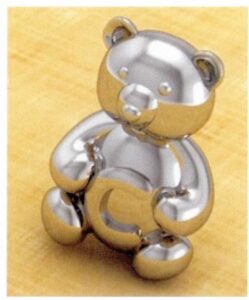
Analiz:
For precious metal jewelry, considering cost and market acceptance, it is necessary to control the weight of metal. This needs to be ensured from the mold-making stage to meet the jewelry’s external dimensions and structural strength by hollowing out hidden parts, such as the back and concave areas, as much as possible to reduce product weight. In this case, if only a three-dimensional effect on the front is required, the molds can be made only half, hollowing out the back. If a three-dimensional round carving effect is needed, the master mold design can be made into two parts for the front and back, with the insides of both parts hollowed out. The back can be made into a caged back to significantly reduce weight.
10. The structure of the master mold is unreasonable
The master mold structure has a significant impact on the quality control of subsequent processes. The unreasonable design of the master mold easily causes defects and increases production difficulty and processing workload. The master mold structure design should ensure that the product meets the customer’s dimensional requirements and fully considers the operability of the production process. Here are some common examples of unreasonable master mold structures.
[Case 5-12] The master mold is not disassembled, and the internal parts cannot be sanded, as shown in Figure 5-13.
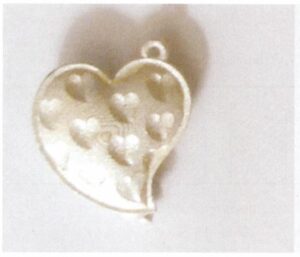
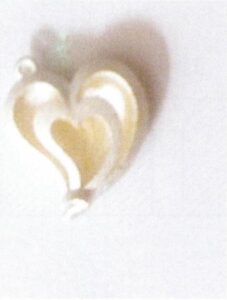
Analiz:
The main body of the earrings, in this case, is heart-shaped. To reduce weight, small heart-shaped hollows are cut out on both sides of the heart shape, and the inside of the heart shape is hollowed out. However, during the CAD drawing, the operability of the holding molds and the mold during production was not fully considered, resulting in the entire heart shape being formed, making it impossible for the replicated silver mold to handle the hollowed interior cavity. Subsequent rubber mold and product finish are, of course, difficult.
Çözümler:
Separate the heart shape into two halves and wax them separately. Set positioning protrusions and grooves on the joint surface, as shown in Figure 5-14. After the two halves of the silver mold are appropriately sanded, assemble them for mold making & correctness, and then make the rubber mold separately.
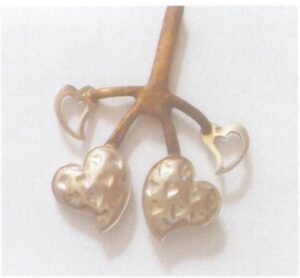
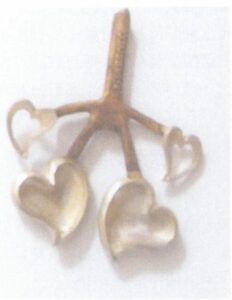
[Case 5-13] The master mold inlay holes in the master mold are small and deep, as shown in Figure 5-15.

Analiz:
This kind of inlay hole structure is not conducive to production or the optical effect of diamonds. Because the small and deep inlay holes are not easy to smooth during casting and even often get blocked, it is challenging to perform mold making and polishing properly, and it is not easy to molds during electroplating, making the diamonds look dark. Sometimes, it is necessary to manually press the bottom of the stone to make it shiny, which could be more efficient and effective.
Çözümler:
Various cutting and grinding styles of gemstones have corresponding thicknesses. When making molds, the relationship between the diameter and depth of the inlay holes should be considered. Gemstone inlays should be both stable and have a good luster, so the size of the inlay holes should be set reasonably. Since the stability of gemstones depends only on the setting base position and the wrapping of the metal edge, the gemstone below the girdle does not touch the inlay hole wall.
In principle, as long as the depth of the setting hole slightly exceeds the thickness of the gemstone. Therefore, the setting stone part can be thinned by hollowing out the bottom, as shown in Figure 5-16.

[Case 5-14] The master mold hollow part is too slender, as shown in Figure 5-17.

Analiz:
Jewelry pieces often have a hollow structure. If the hollow part is designed to be too slender, the delicate part of the rubber mold will hang down, causing swinging during wax injection, leading to defects such as misalignment and flash. During wax injection, the delicate part of the rubber mold may also tear off, or the delicate gypsum may break off during the making of the plaster mold, resulting in the disappearance of the slender hole in the workpiece.
Çözümler:
The hollow part in the master mold should be considered in combination with the production process on the premise of meeting the design requirements. In this example, the hollow part is on the inner wall, aiming to reduce weight without affecting the appearance. Therefore, when making the molds, the hollow part should be set as an easily machinable arc, and the two corresponding hollow positions should be separated, as shown in Figure 5-18. In addition, while meeting the inlay size requirements, the bottom of the annular inlay should be appropriately removed to reduce the depth of the hollow part.

[Case 5-15] The master mold has sharp angles at the connecting parts or recessed decorations, as shown in Figure 5 -19.
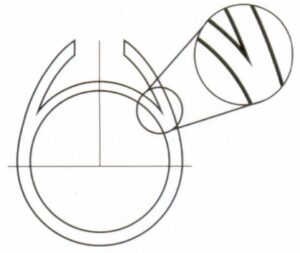

Analiz:
This sharp angle connection will cause several problems: the rubber mold is prone to tearing during production, resulting in uneven edges in the final product; the fragile gypsum is prone to breakage when making the plaster mold; during casting, the metal liquid is prone to turbulence. Causes defects such as pores and inclusions in the workpiece; it is difficult to polish the sharp corner, and when mechanical polishing is used, these areas are easily embedded with polishing media; if the casting sprue point is improperly positioned, the workpiece is prone to metal withering.
Çözümler:
Modify the sharp corner to a rounded corner, as shown in Figure 5-20, and determine the size of the rounded corner according to the design requirements.

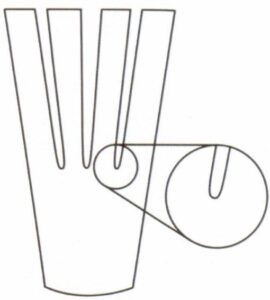
[Case 5-16] The master mold has a narrow opening in the side wall, as shown in Figure 5-21.

Analiz:
In addition to hollowing out the bottom of the jewelry in the master mold, a layer is generally opened on the side walls of those with higher side walls. In this case, the claw setting of the main stone also has a layer opened on the side wall of the setting, which is not only to reduce weight but also to improve the brilliance of the gemstone.
However, when the opening of the layer is narrow, it is not conducive to the positioning of the wax injection mold during wax injection, leading to deformation of the opening of the layer, and it is also not conducive to removing the wax model from the rubber mold.
It is also not conducive to removing the wax model from the rubber mold when the opening of the layer is narrow.
Çözümler:
Properly widen the interlayer opening, as shown in Figure 5-22.

[Case 5-17] The pendant’s hanging part is not smooth in moving, as shown in Figure 5-23.
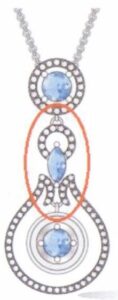
Analiz:
In this case, each connecting part of the pendant is connected by a jump ring, requiring each pendant part to swing smoothly. However, during mold making, due to insufficient space between the connecting jump rings, the swinging is easily hindered.
Çözümler:
Increase the gap at the connection part appropriately while meeting the design aesthetics, ensuring sufficient clearance between mating parts for adequate movement allowance.
[Case 5-18] The master mold wall thickness varies greatly, as shown in Figure 5-24.
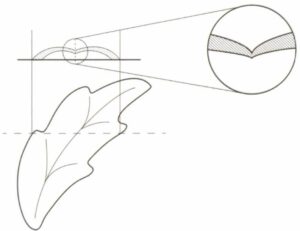
Analiz:
In this case, the leaf-shaped workpiece has the thinnest leaf veins in the middle, and the leaf petals are thicker on both sides, with the thickness increasing as it moves away from the central leaf vein. During casting, the thin part will obstruct the feeding channel, leading to shrinkage of porosity in the thick wall area and deteriorating the surface quality. Sometimes, when the wall thickness at the thin part is too small, it may crack due to insufficient strength.
Çözümler:
When designing the master mold structure, try to avoid the thick-thin-thick structure. The thin part should have a bare thickness, and the thick part can be hollowed out by adding a ridge to the back and digging out the bottom to reduce the difference in wall thickness between various parts.
[Case 5-19] The master mold stone inlay hole was not drilled through, as shown in Figure 5-25.

Analiz:
For the parts that need to be inlaid with stones, the stone inlay holes should be drilled on the master mold to ensure the consistency of inlay quality during mass production, reduce the loss of precious metals, improve production efficiency, and avoid missing inlays in products. This issue should be paid more attention to in dense inlays of multiple small gemstones.
【Case 5-20】The pearl cap diameter is too small, as shown in Figure 5-26.

Analiz:
The general method of setting pearls is to drill holes in the pearls, apply glue to the metal pin and pearl protrusion, then insert the pin into the pearl hole, and wait for the glue to harden and fix. The size of the pearl protrusion should be appropriate, covering the pearl hole without being too large to cause a disproportionate ratio. In this case, the diameter of the pearl protrusion is too small, making it easy for the glue to overflow onto the pearl protrusion, increasing the cleaning workload and the risk of scratching the pearl.
11. Poor Master mold Surface Quality
The master mold surface quality determines the product’s surface quality, and the master mold must achieve a smooth and clean surface to reduce the workload of polishing and repairing in subsequent processes. Common defects in master mold surface quality are as follows.
【Case 5-21】Welding scars appear at the master mold welding site, as shown in Figure 5-27.
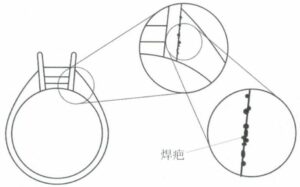
Analiz:
In this example, the claw setting of the ring is welded together with the ring band, resulting in many unclean weld scars at the welding site. When the master mold is used for production, the weld scars will transfer to each workpiece, leading to a significant amount of rework. In other words, this defect is replicated in large quantities.
Çözümler:
Careful handling of the welding site is required, using appropriate tools to polish it smoothly and brightly.
[Case 5-22] Scratches on the master mold surface, as shown in Figure 5-28.

Analiz:
Casting the master mold requires processes such as filing, sanding, and making casting sprue to obtain a smooth surface. If the pre-process treatment is too heavy during the molds-making process, it will cause deep scratches that are difficult to remove in subsequent processes or require changing the shape of the molds to remove them.
Çözümler:
When making the molds, follow a surface treatment process from coarse to OK, choose the appropriate tools for each process, master the operation force, and the subsequent process should reprocess the entire surface of the previous process.
[Case 5-23] Master mold missed sanding at the inlay, as shown in Figure 5-29.
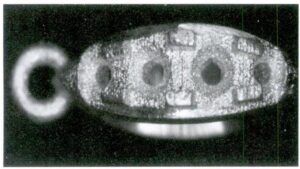
Analiz:
In this case, the inlay of the master mold leaked, still retaining the rough and uneven casting surface.
[Case 5-24] There are sand holes on the master mold surface, as shown in Figure 5-30.
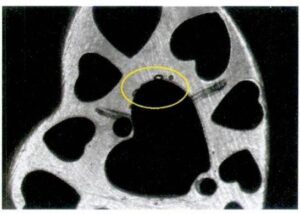
Analiz:
In the casting process, many factors of the master mold will lead to sand hole defects, including the casting process, mold, metal materials, product structure, etc.
[Case 5-25] The master mold dead corner is not sanding enough, as shown in Figure 5-31.
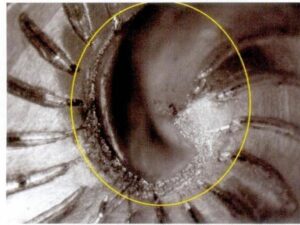
Analiz:
In this case, the root of the central spiral in the master mold belongs to a dead corner position, which is difficult to reach with ordinary tools. After sanding, this part still appears rough and cannot be removed.
Çözümler:
In the jewelry versioning process, due to the significant structural differences of the master mold, conventional standard tools sometimes cannot handle dead corners, concave areas, etc. A specific tool needs to be made by the workers themself to sand these areas.
[Case 5-26 ] Master mold edges are not smooth, as shown in Figure 5-32.
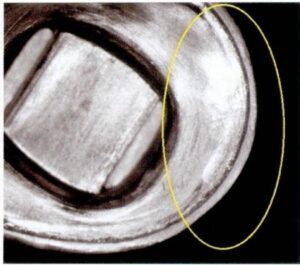
Analiz:
When finishing jewelry, edges should be smooth without apparent uneven thickness. The master mold in this example did not meet this requirement, showing noticeable edges that were not smooth, which is related to the operator’s technique.
12. the master mold casting sprue problem
The casting sprue is not only the channel for the metal liquid to enter the mold cavity but also the channel for supplementing the solidifying and shrinking metal liquid for the casting. Whether the casting sprue is set reasonably or not is related to whether the casting is sound, whether the surface is dense, etc., and must be taken seriously. Several common master mold casting sprue setting problems are as follows.
[Case 5-27 ] The casting sprue is too small, as shown in Figure 5-33.
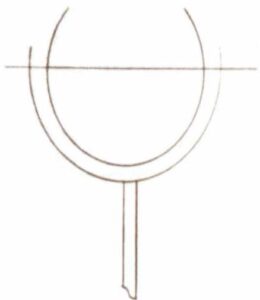
Analiz:
When the casting sprue is too small, the rise of the metal liquid level in the cavity is slow, which may lead to defects such as incomplete defects. The scouring force of the metal liquid on the mold wall is large, which can cause defects such as sand holes and blowholes. During the solidification process of the casting, the metal liquid’s supplementary shrinkage channel is blocked, which can lead to macroscopic shrinkage cavities and microscopic shrinkage looseness in the workpiece.
Çözümler:
The size of the casting sprue should be determined based on the characteristics of the casting metal material, the size and structural characteristics of the casting, the casting method, etc. Generally speaking, the cross-sectional area of the casting sprue should be 70%-150% at the connection with the workpiece. Therefore, the master mold casting sprue in this example can be appropriately enlarged, as shown in Figure 5-34.
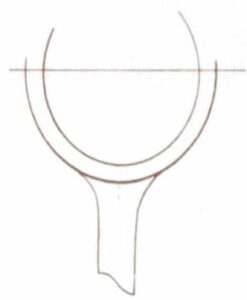
【Case 5-28】The position of the casting sprue does not meet the requirements for filling and shrinking, as shown in Figure 5-35.
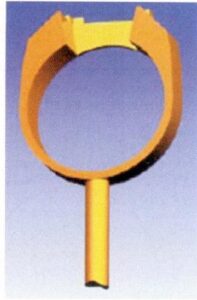
Analiz:
For the ring, in order to facilitate the subsequent polishing and reduce the impact on the appearance, the casting sprue is generally set at the shank. However, in this case of the ring, the sides of the ring head are solid, thick, walled structures, and these two areas solidify last; their shrinkage cannot be compensated by external metal liquid, resulting in severe shrinkage porosity.
Çözümler:
According to the general principle set by the casting sprue, it should be set at the thick wall part of the casting. If the structure of the ring does not allow changes, the ring must be inverted. Double support casting sprues should be set, connected to the thick section respectively; if it is permitted to hollow out the inside of the ring while maintaining the same shape, the thickness of the two thick wall parts can be reduced to be less than the wall thickness of the ring handle. Then, the casting sprue can be set at the ring handle. As shown in Figures 5-36 and 5-37.
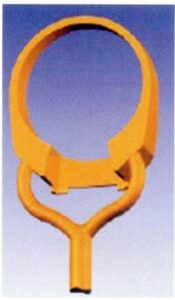

[Case 5-29 ] The position of the casting sprue is challenging to clean, as shown in Figure 5-38.
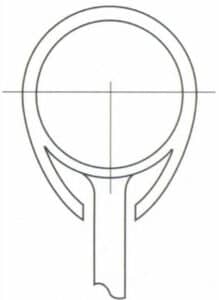
Analiz:
The casting sprue is a process measure required for casting molding, not required by the casting itself. After casting molding, the casting sprue needs to be removed. The casting sprue, in this case, is set in the interlayer of the ring, which is challenging to cut. Tools such as steel files and sandpaper are also complex to enter during modeling, making it difficult to clean the residual casting sprue.
Çözümler:
The casting sprue should be set on the outer smooth surface as much as possible for easy cleaning, as shown in Figure 5-39.
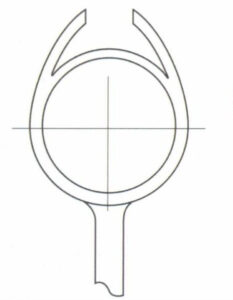
【Case 5-30】The casting sprue is connected to the casting at a right angle, as shown in Figure 5-40.
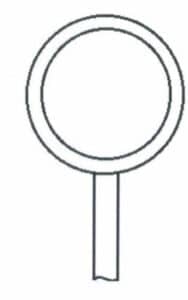
Analiz:
When the sprue is connected to the workpiece at a right angle, turbulence is easily generated in the molten metal during the filling process, causing problems such as gas entrapment and slag entrapment, and thermal nodes can form at the connection, leading to shrinkage porosity at that location. If the pressure of the molten metal is high, the gypsum wall facing the flow of the molten metal is easily eroded and abraded, causing defects such as inclusions and sand holes.
Çözümler:
The casting sprue should be connected to the casting with a fillet, which can make the filling of the molten metal smooth and reduce abrasion on the mold wall. The size of the fillet should comprehensively consider factors such as the cross-sectional size of the casting sprue, the wall thickness of the casting, and the ease of cleaning.
【Case 5-31】A thin-walled casting has an oversized casting sprue, as shown in Figure 5-41.
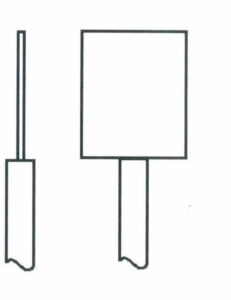
Analiz:
Connecting a large sprue to a thin section, if the temperature of the molten metal and gypsum is improper, can cause the sprue to shrink and loosen, extending to the connection area and causing the so-called ‘backflow’ phenomenon.
Çözümler:
Setting casting sprues on thin-walled castings to eliminate the misconception that larger casting sprues ensure complete filling. In fact, the filling capacity of the molten metal depends not only on the casting sprues but also on the flow of the molten metal in the mold cavity. The larger and thinner the casting, the easier it is to cool down and cause filling-related defects. At this point, simply increasing the cross-section of the casting sprue will not solve the problem. It is necessary to increase the number of casting sprues and shorten the range covered by each casting sprue in the mold cavity, as shown in Figure 5-42.
